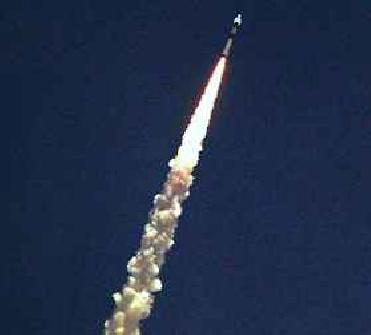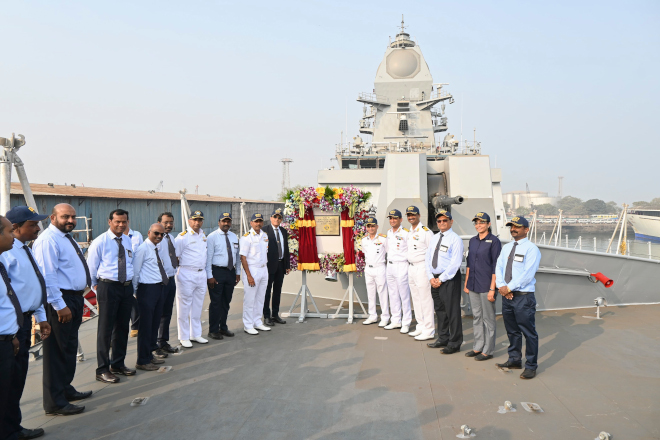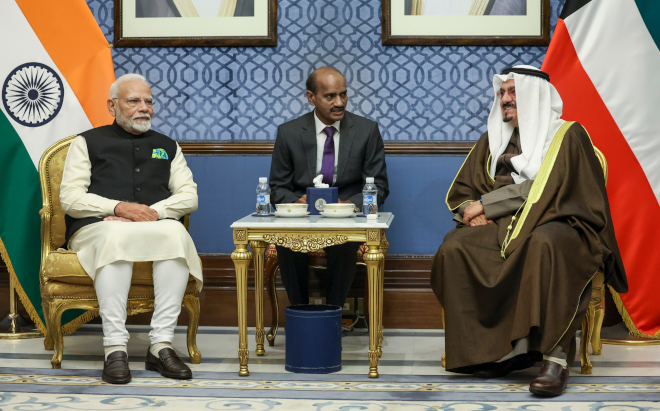
PSLV C-14 leaves a trail of smoke during its launch from Satish Dhavan Space Centre in Sriharikota, Andhra Pradesh, on Wednesday. Image credit: PTI
SRIHARIKOTA (PTI): ISRO on Wednesday placed seven satellites, including Oceansat-2, in orbit within a span of 20 minutes – its first successful mission after the abrupt end of the ambitious Chandrayaan-I project.
At the end of the 51-hour countdown, the 44.4 meter tall four-stage PSLV-C14 blasted off from the first launch pad at the Satish Dhawan Space Centre here with ignition of the core first stage, and put the satellites in orbit one after another.
Scientists cheered as ISRO's workhorse, PSLV soared majestically into clear skies at 1151 IST from the spaceport in the East Coast of Andhra Pradesh, about 100 km north of Chennai, with the launch witnessed by Vice President Hamid Ansari.
Oceansat-2, the country's 16th remote sensing satellite, will identify potential fishing zones, sea state forecasting and coastal zone studies, besides providing inputs on weather forecasting and climate studies.
A set of six nano satellites rode piggyback accompanying Oceansat-2 on its trip to orbit.
Ansari and senior scientist M G K Menon, who were present in the mission centre, congratulated ISRO scientists soon after the successful launch.
Besides two German Rubin nano satellites, other Oceansat-2 co-passengers are four cubesats: Beesat, built by Technical University Berlin, UWE-2 (University of Wuerzburg Germany), ITU-pSat(Istanbul Technical University Turkey) and SwissCube-1 (Ecole Polytechnique Federal de Lausanne, Switzerland).
Addressing scientists, ISRO Chairman G Madhavan Nair described it as “a perfect and precise launch.”
Congratulating space scientists for the fantastic achievement, Nair said “the launch has once again proved our capability. It is an example of fine teamwork and the maturity of PSLV launch vehicle has been proved.”
An in-orbit replacement to Oceansat-1, which was used to study physical and biological aspects of oceanography, Oceansat-2 will have a mission life of five years. Oceansat-1 has completed 10 years of space odyssey.
The nano satellites, between two and eight kg range, are educational spacecraft from European Universities intended to test new technologies.
Oceansat-2 was injected into space first and the remaining were placed in orbit one after another, officials said.
The eight band Ocean Colour Monitor carried by Oceansat-2 images a swath (strip of land or ocean) of 1,420 km with a resolution of 360 metres and works in the visible and Near infrared region of the electromagnetic spectrum. The Scatterometer covers a swath of 1,400 km and operates continuously.
In April 2008, ISRO had launched 10 satellites in a single mission – one big spacecraft (Cartosat-2A) and nine nano satellites.
Oceansat-2 was placed in polar sunsynchronous orbit, 720 km above Earth, as in the case of its predecessor.
Wednesday’s PSLV was a core alone version without six strap on motors that surround the first stage in the standard PSLV format.
PSLV's fourth stage fired five satellites into orbit and the two Rubin satellites will remain permanently attached to the vehicle's fourth stage.
Rubin satellites, which were not separated, will do their work while attached to the PSLV fourth stage, according to ISRO officials.














The Indian Air Force, in its flight trials evaluation report submitted before the Defence Ministry l..
view articleAn insight into the Medium Multi-Role Combat Aircraft competition...
view articleSky enthusiasts can now spot the International Space Station (ISS) commanded by Indian-American astr..
view article